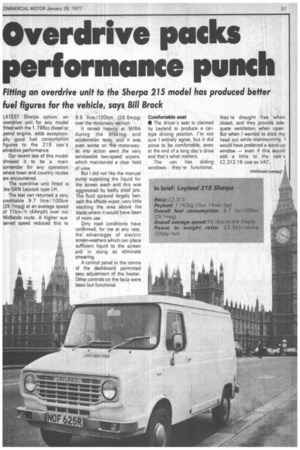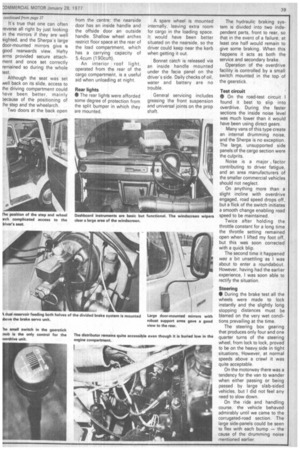Overdrive packs performance punch
Page 41

Page 43

If you've noticed an error in this article please click here to report it so we can fix it.
Fitting an overdrive unit to the Sherpa 215 model has produced better fuel figures for the vehicle, says Bill Brock
LATEST Sherpa option, an overdrive unit for any model fitted with the 1,798cc diesel or petrol engine, adds exceptionally good fuel consumption figures to the 215 van's attractive performance.
Our recent test of this model .showed it to be a main contender for any operation where town and country routes are encountered.
The overdrive unit fitted is the GKN Laycock type LH.
The test van returned a very creditable 9.7 litre/100km (29.1mpg) at an average speed of 71km/h (44mph) over our Midlands route. A higher sustained speed reduced this to 9.9 litre/100km (28.6mpg) over the motorway section.
It rained heavily at MIRA during the braking and acceleration tests, and it was even worse on the motorway, so into action went the very serviceable two-speed wipers, which maintained a clear field of view.
But I did not like the manual pump supplying the liquid for the screen wash and this was aggravated by badly sited jets The fluid sprayed largely beneath the offside wiper, very little reaching the area above the blade where it would have been of more use.
Dirty road conditions have confirmed, for me at any rate, the advantages of electric screen-washers which can place sufficient liquid to the screen anti in doing so eliminate smearing.
A control panel in the centre of the dashboard permitted easy adjustment of the heater. Other controls on the facia were basic but functional. Comfortable seat • The driver's seat is claimed by Leyland to produce a cartype driving position. I'm not sure I entirely agree, but it did prove to be comfortable, even at the end of a long day's drive and that's what matters.
The van has sliding windows they're functional, they're draught free when closed, and they provide adequate ventilation when open. But when I wanted to stick my head out while manoeuvring, I would have preferred a wind-up window — even if this would add a little to the van's £2,313.16 cost ex VAT. It's true that one can often reverse all right by just looking in the mirrors if they are well sighted, and the Sherpa's large door-mounted mirrors give la good rearwards view. Hefty arms provided secure attachment and once set correctly remained so during the whole test.
Although the seat was set well back on its slide, access to the driving compartment could have been better, mainly Deca use of the positioning of :he step and the wheelarch.
Two doors at the back open from the centre; the nearside door has an inside handle and the offside door an outside handle. Shallow wheel arches restrict floor space at the rear of the load compartment, which has a carrying capacity of 5.4cum (1 90cuft).
An interior roof light, operated from the rear of the cargo compartment, is a useful aid when unloading at night.
Rear lights • The rear lights were afforded some degree of protection from the split bumper in which they are mounted. A spare wheel is mounted internally, leaving extra room for cargo in the loading space. It would have been better situated on the nearside, so the driver could keep near the kerb when getting it out.
Bonnet catch is released via an inside handle mounted under the facia panel on the driver's side. Daily checks of oil, water and battery a re n o trouble.
General servicing includes greasing the front suspension and universal joints on the prop shaft. The hydraulic braking system is divided into two independent parts, front to rear, so that in the event of a failure, at least one half would remain to give some braking. When this happens it acts as both the service and secondary brake.
Operation of the overdrive facility is controlled by a small switch mounted in the top of the gearstick.
Test circuit • On the road-test circuit I found it best to slip into overdrive. During the faster sections the inside noise level was much lower than it would have been using direct gears.
Many vans of this type create an internal drumming noise, and the Sherpa is no exception. The large, unsupported side panels of the cargo section were the culprits.
Noise is a major factor contributing to driver fatigue, and an area manufacturers of the smaller commercial vehicles should not neglect.
On anything more than a slight incline with overdrive engaged, road speed drops off, but a flick of the switch initiates a smooth change enabling road speed to be maintained.
Twice after holding the throttle constant for a long time the throttle setting remained open when I lifted my foot off, but this was soon corrected with a quick blip.
The second time it happened was a bit unsettling as I was about to enter a roundabout. However, having had the earlier experience, I was soon able to rectify the situation.
Steering • During the brake test all the wheels were made to lock instantly and the slightly long stopping distances must be blamed on the very wet conditions prevailing at the time.
The steering box gearing that produces only four and one quarter turns of the steering wheel, from lock to lock, proved to be on the heavy side in tight situations. However, at normal speeds above a crawl it was quite acceptable.
On the motorway there was a tendency for the van to wander when either passing or being passed by large slab-sided vehicles, but I did not feel any need to slow down.
On the ride and handling course, the vehicle behaved admirably until we came to the corrugated-road section. The large side-panels could be seen to flex with each bump — the cause of the drumming noise mentioned earlier.


































































































